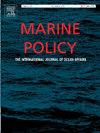Regulation of the Caribbean red snapper fishery on the Amazon continental shelf: 60 years of conflict between conservation and exploitation
IF 3.5
2区 社会学
Q2 ENVIRONMENTAL STUDIES
引用次数: 0
Abstract
The Caribbean red snapper (Lutjanus purpureus) is a fish of the family Lutjanidae that occurs in the Caribbean and western Atlantic between southern Cuba and the northeastern Brazilian state of Pernambuco, in northeastern Brazil. This snapper is one of the target species most exploited by commercial fisheries in this region. It was first fished in 1960s on the oceanic banks off Recife, in Pernambuco, and Fortaleza, in Ceará state. In the subsequent decades, the Brazilian red snapper stocks have undergone constant fishing pressure and a number of distinct depletion events. The fishery currently operates on the Amazon continental shelf, in addition to northeastern Brazil, and supplies primarily the North American market. Despite the continuous and ongoing management of red snapper fisheries in Brazil, there is considerable evidence that the legal regulations that govern the development of this sector are not adhered to, which, in addition to a twelve-fold increase in landings between 1960 and 2013, led the species to be classified as a Vulnerable by ordinance number 445 of 2014 of the Brazilian Ministry for the Environment (MMA). A number of studies have shown that the species is overexploited, with size at first maturity (L50) being reduced from 43.2 cm in 2002 to 32.1 cm in 2022, and self-reported records 50 % below export volumes. We used snapper productivity data from 1990 onward, which refer to phase 4 of the fishery, that now operates on the Amazon and Northeastern continental shelves. We used four public databases of fishery productivity that included red snapper as a category or record descriptor for the present study: ComexStat, CEPNOR, NOAA, and the ‘Painel do Pargo’ (red snapper panel), and government websites were also consulted to locate management ordinances for the species. We found the maintenance of logbooks, the satellite tracking of vessels, and the control of fishing effort are mandatory but not carried out by the Brazilian red snapper fishery, and there is evidence of discrepancy between NOAA and ComexStat data and exportaxion and importation data. Besides, the lack of compliance with the official regulations on the part of the fishing industry, and the reduced levels of government monitoring have resulted in Lutjanus purpureus being included on the Brazilian list of threatened species. Those results demonstrates that to recover the Brazilian Lutjanus purpureus stocks, government institutions will need to develop effective continuous monitoring strategies for the fishery, which will permit the compilation of good quality data and, above all, they must strengthen their capacity for the control and inspection of this sector’s activities, to guarantee compliance with the regulations.
亚马逊大陆架加勒比红鲷鱼渔业的管理:保护与开发之间的60年冲突
加勒比红鲷鱼(Lutjanus purpureus)是加勒比红鲷鱼科的一种鱼,产于古巴南部和巴西东北部伯南布哥州之间的加勒比海和西大西洋。这种鲷鱼是该地区商业渔业最常捕捞的目标物种之一。它最早于20世纪60年代在伯南布哥省累西腓和塞埃尔州福塔莱萨的海洋岸边被捕捞。在随后的几十年里,巴西红鲷鱼种群经历了持续的捕捞压力和一些明显的枯竭事件。除巴西东北部外,该渔业目前在亚马逊大陆架经营,主要供应北美市场。尽管巴西对红鲷鱼渔业进行了持续和持续的管理,但有相当多的证据表明,管理该部门发展的法律法规没有得到遵守,这除了1960年至2013年期间捕捞量增加了12倍之外,还导致该物种被巴西环境部(MMA) 2014年第445号法令列为易危物种。许多研究表明,该物种被过度开发,初成熟尺寸(L50)从2002年的43.2 cm减少到2022年的32.1 cm,自述记录比出口量低50% %。我们使用了1990年以后的鲷鱼产量数据,这是渔业的第四阶段,现在在亚马逊和东北大陆架上运作。我们使用了四个渔业生产力的公共数据库,包括红鲷鱼作为本研究的一个类别或记录描述:ComexStat、CEPNOR、NOAA和“Painel do Pargo”(红鲷鱼面板),并咨询了政府网站,以确定该物种的管理条例。我们发现航海日志的维护、船只的卫星跟踪和捕捞努力量的控制是强制性的,但巴西红鲷鱼渔业没有执行,并且有证据表明NOAA和ComexStat的数据与进出口数据之间存在差异。此外,由于捕鱼业不遵守官方规定,以及政府监测水平的降低,导致红腹露鳕被列入巴西濒危物种名单。这些结果表明,为了恢复巴西紫头露头鱼的种群,政府机构将需要为渔业制定有效的持续监测战略,从而能够汇编高质量的数据,最重要的是,它们必须加强其控制和检查该部门活动的能力,以保证遵守条例。
本文章由计算机程序翻译,如有差异,请以英文原文为准。
求助全文
约1分钟内获得全文
求助全文
来源期刊

Marine Policy
Multiple-
CiteScore
7.60
自引率
13.20%
发文量
428
期刊介绍:
Marine Policy is the leading journal of ocean policy studies. It offers researchers, analysts and policy makers a unique combination of analyses in the principal social science disciplines relevant to the formulation of marine policy. Major articles are contributed by specialists in marine affairs, including marine economists and marine resource managers, political scientists, marine scientists, international lawyers, geographers and anthropologists. Drawing on their expertise and research, the journal covers: international, regional and national marine policies; institutional arrangements for the management and regulation of marine activities, including fisheries and shipping; conflict resolution; marine pollution and environment; conservation and use of marine resources. Regular features of Marine Policy include research reports, conference reports and reports on current developments to keep readers up-to-date with the latest developments and research in ocean affairs.
 求助内容:
求助内容: 应助结果提醒方式:
应助结果提醒方式:


